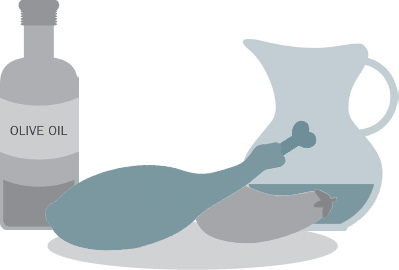
There are as many lifestyles as there are people and any approach to cooking and entertainment necessarily includes a whole range of diverse possibilities that reflect the intricate mosaic of Palestinian culture. Through a weakness on my part I succumbed to the urge of suggesting menus which, I believe, reflect the different approaches to food among certain Palestinians; however, they should by no means limit your perception of other possibilities which, I hope, have transpired through the introductions to the different sections and the individual dishes.
While most Palestinians prefer to entertain in the traditional way, especially for festive and ceremonial occasions, many cooks, mostly among the more cosmopolitan, urban sections of society, also pride themselves on being able to serve international dishes at their table. For a long time they have adopted western practices as a symbol of distinction and sophistication. Lately, however, a renewed consciousness in the value of traditional food has manifested itself at social and family gatherings and serving regional dishes has become quite the thing. This phenomenon is generally rooted in the broad cultural revival that is sweeping Palestine, but it also has to do with an awareness of the worth and appeal of Palestinian cookery and the tremendous opportunities it offers for creativity and refinement.

Nothing beats a spring or early summer late morning brunch served on the terrace or in the hadir, the closed patio, followed by a hubbly-bubbly (the Middle Eastern water-pipe also known as narghileh) and a game of cards that stretches way into the afternoon.
Brunch parties have become quite common on holidays and weekends. Following is a suggested menu of a light brunch for a small party.
Falafel (chickpea fritters)
Fried eggs with sumak
Marinated olives
Labaneh, slightly salted and sour cream cheese, served with olive oil and mint leaves.
Zeit u za’tar, a spice mix with a thyme base served with olive oil
Traditional white cheese
Tabun bread, baked in the traditional outdoor clay oven, the tabun
Mint tea

Following is a suggested assortment of mezze for an informal gathering.
Using the same quantities indicated in the recipes, it can serve 15 people.
Cold salads
Hummos; m’tabbal; ful m’dammas; bakdounsieh; tomatoes with thyme salad; fried aubergines and marrows with yoghurt and pine nuts;
Traditional tahineh salad.
Relishes and pickles
Hot peppers marinated in olive oil; olives marinated in olive oil and garlic; pickled cucumbers, cauliflower and turnips; fresh raw spring onions trimmed and washed.
Hot pastries (mou‘ajjanat)
Sfiha; cheese sambousek; meat sambousek.

To celebrate a special occasion with a larger crowd of guests, a brunch is quite the ‘in’ way to entertain, provided you have help or you are organised enough to plan ahead. The items on this menu can easily be prepared ahead. The advantage is that you can serve all the dishes all at once, except for the dessert.
Falafel (chickpea fritters)
Ful m’dammas
Sambousek with meat
Fried white sheep’s cheese, served on a bed of greens
Labaneh served with olive oil and a variety of fresh herbs on the side
Raw vegetables: cucumbers, tomatoes, spring onions and any other vegetable in season served sliced with tahineh dip
Black and green marinated olives
Qras b’za’tar
Tabun bread
For dessert
Tamriyyeh or m’tabbaq
Tea with aniseed biscuits

Choice of three salads
Cheese sambousek
Sfiha
Moussaka‘a
Stuffed chicken
Oriental rice
Choice of steamed vegetables
Esh el’saraya
Ghraybeh
Fruit salad
Assortment of salads
Artichokes with coriander
Spinach breads
Malfouf
Roasted leg of lamb
Choice of steamed vegetables
Ka‘k and Ma‘moul
Knafeh or mhallabiyeh
Lentil soup with Swiss chard
M’tabbal
Avocado salad
Beet salad
Spinach breads
Okra with tomatoes
Stuffed vine leaves and marrows (siami)
Farayek
Apricots in syrup
Fruit salad
Dates with laban
Chicken soup
Assortment of salads
Pan kubbeh with aubergine salad
Sheikh el-mahshi
Fattet djaj
Qatayef
Apricots in syrup
Heytaliyieh
The Armenian community has been part of the Palestinian cultural mosaic since the middle of the fifth century. The first nation to adopt Christianity as its official religion at the beginning of the fourth century, Armenian pilgrims have flocked to the Holy Land ever since and their presence has been continuous, growing to a significant size right after the Turkish massacre of Armenians in 1915. The third most important Christian community in Palestine, the middle of the nineteenth century witnessed expansion of its territory around the Monastery complex within the old city of Jerusalem and progress in the fields of commerce, education and services to the community and the many pilgrims who flocked there.
Although important demographic changes have occurred within the last fifty years, with many Armenians moving out of the convent complex, and others emigrating to different parts of Europe, America and Australia, the convent will always be the focal point of the Armenian Quarter and the heart of the community.
Bartlett’s description of the exterior of the convent area in 1842 is as true today as it was then. The Armenian Quarter has been spared the development projects that have transformed the other quarters of Jerusalem into shabby tourist sites and kitschy residential areas:
The only building in Jerusalem that presents any considerable appearance of comfort; the compactly built facade, the neatly paved street in front, overshadowed by noble trees, and the portly and highly respectable looking monks about its doorway, are all redolent of ease, and wealth, and cleanliness rare in the city of Jerusalem.
Bartlett, Walks
One and a half centuries later, William Dalrymple’s impressions testify to the preserved authenticity of that section of the Old City:
The Armenian Quarter is very different. It is easy to pass it by without realising its existence. It is a city within a city, entered through its own gate and bounded by its own high, butter coloured wall.
The gatehouse gives onto a warren of tunnels and passageways. Off one of these I have been given an old groin-vaulted room smelling of dust and old age, with a faint whiff of medieval church. In the streets around my room, hidden behind anxiously twitching lace curtains, lives a displaced population, distinct from their neighbours in language, religion, history and culture.
William Dalrymple, From the Holy Mountain
Armenian food as it is cooked in Jerusalem does not call for a particular variety of spices, one explanation being that the Armenian community adopted a lot of the local culinary culture. Fenugreek, however, is particularly Armenian and is the basic spice used in the preparation of basturma, a spicy dried meat available in most Armenian restaurants of Jerusalem and Bethlehem. However, only a select few are lucky to benefit from the basturma prepared in the kitchens of the convent.
When Armenians meet for a festive meal, the food is guaranteed to be abundant, the noise ear shattering and the singing maudlin. An Armenian Christmas menu follows.
Assortment of salads
Basturma
Stuffed artichokes
White bean casserole
Meat and cheese sambousek
Pot roast
Choice of vegetables
Armenian halaweh
Anush abur (wheat pudding)
